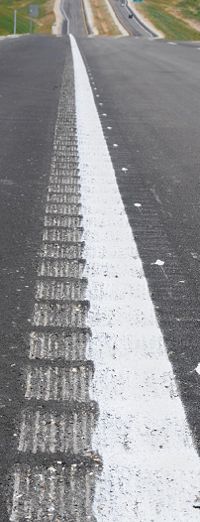106.3.2.80 TM-80, Measurement of Retroreflectivity by Handheld Retroreflectometers
This method describes retroreflectivity inspections of pavement markings using a handheld retroreflectometer.
106.3.2.80.1 Equipment

The apparatus shall consist of a handheld 30-meter geometry retroreflectometer, such as the Mirolux 30 retroreflectometer.
106.3.2.80.2 Procedure
Take the pavement marking measurements between seven and fourteen days after application. Waiting seven days ensures that all excess glass spheres have been removed, and completing the measurements by fourteen days allow retest of the pavement marking within 45 days if the handheld reflectometer measurements are challenged.
Take all measurements in the sampling areas in the direction of traffic flow, except on the centerline of two-lane roads, then take the required number of measurements in each direction. Measure both single and double lines, and apply the acceptance criteria for each line in both directions.
Because handheld retroreflectometers normally shoot a beam of light approximately 6-12 in. ahead of the machine’s lens, locate the lens approximately 6-12 in. from the flat area of the rumble strip. When the light falls in the bottom of a rumble strip, the retroreflectivity readings are usually lower than the backside or top of the rumble area because of the change of light beam angle, and for that reason, take care to avoid taking readings in the bottom of the rumble strip.
106.3.2.80.3 Sampling
106.3.2.80.3.1 Solid Longitudinal Lines
106.3.2.80.3.1.1 Road Lengths 1000 Ft.
Randomly select one 300 ft. section of pavement marking for testing. Take measurements approximately every 15 ft. along the pavement marking line. Take a total of 20 measurements.
106.3.2.80.3.1.2 1000 Feet < Road Lengths One Mile
Break the roadway to be tested down into segments of equivalent lengths. Keep the segment lengths as close as possible to 1000 ft., but the segments may be as small as 500 ft., as would be the case when the total roadway length to be tested is only 1001 ft. long. Within each segment, randomly select one 300 ft. section of pavement marking for testing. Take measurements within the 300 ft. sections of roadway approximately every 15 ft. along the pavement marking line. Take a total sample size of 20 measurements for each section.
106.3.2.80.3.2 Intermittent Longitudinal Lines
106.3.2.80.3.2.1 Road Lengths 1000 Ft.
Take two measurements on 10 random intermittent pavement markings, giving a total sample size of 20 measurements. Take measurements on each intermittent pavement marking at minimum 3 ft. apart.
106.3.2.80.3.2.2 1000 Feet < Road Lengths One Mile
Break the roadway to be tested down into segments of equivalent lengths. Keep the segment lengths as close as possible to 1000 ft., but the segments may be as small as 500 ft., as would be the case when the total roadway length to be tested is only 1001 ft. long. Within each segment, randomly select one 300 ft. section of pavement marking for testing. Within each 300 ft. section, take two measurements on 10 random intermittent pavement markings, giving a total sample size of 20 measurements for each section. Take measurements on each intermittent pavement marking at minimum 3 ft. apart.
106.3.2.80.3.3 Legends, Symbols, Pedestrian Crossing, Etc.
Retroreflectivity acceptance requirements do not apply to intersection markings, such as stop lines, arrows, legends, pedestrian crossings, symbols, etc. No readings are required. Acceptance is based upon quality of work in accordance with Sec 620.50.3.6.
106.3.2.80.4 Acceptance
Use the number of readings below the minimum accepted values as set in Sec 620 to determine if a pavement marking is accepted or rejected.
For cases in which six or three sample size measurements are taken, calculate the average. If the average falls below the minimum required value, reject the pavement marking.
For cases in which 20 sample measurements are taken for a segment of roadway, if 17 or more readings in the 300 ft. section, or actual length for intermittent longitudinal lines less than 1000 ft., for that segment of roadway are above the minimum value required, accept that segment of pavement marking. If four or more readings within a segment are below the minimum value required, calculate the average value of the failed readings and use the calculated average to determine, if applicable, the amount of deduct that applies to that segment, or if that segment of pavement marking needs to be removed and replaced.
